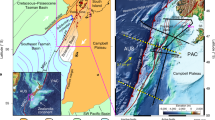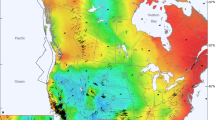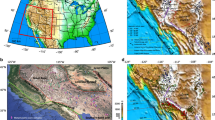Abstract
During Late Cretaceous and Cenozoic times, many Palaeozoic and Mesozoic rifts and basin structures in the interior of the European continent underwent several phases of inversion (the process of shortening a previously extensional basin)1. The main phases occurred during the Late Cretaceous and Middle Palaeocene, and have been previously explained by pulses of compression, mainly from the Alpine orogen2,3,4,5. Here we show that the main phases differed both in structural style and cause. The Cretaceous phase was characterized by narrow uplift zones, reverse activation of faults, crustal shortening, and the formation of asymmetric marginal troughs. In contrast, the Middle Palaeocene phase was characterized by dome-like uplift of a wider area with only mild fault movements, and formation of more distal and shallow marginal troughs. A simple flexural model explains how domal, secondary inversion follows inevitably from primary, convergence-related inversion on relaxation of the in-plane tectonic stress. The onset of relaxation inversions was plate-wide and simultaneous, and may have been triggered by stress changes caused by elevation of the North Atlantic lithosphere by the Iceland plume6 or the drop in the north–south convergence rate between Africa and Europe7.
This is a preview of subscription content, access via your institution
Access options
Subscribe to this journal
Receive 51 print issues and online access
$199.00 per year
only $3.90 per issue
Buy this article
- Purchase on Springer Link
- Instant access to full article PDF
Prices may be subject to local taxes which are calculated during checkout



Similar content being viewed by others
References
Voigt, E. Über Randtröge vor Schollenrändern und ihre Bedeutung im Gebiet der Mitteleuropäischen Senke und angrenzender Gebiete. Z. Deutsch. Geol. Gesell. 114, 378–418 (1962)
Ziegler, P. A. Late Cretaceous and Cenozoic intra-plate compressional deformations in the Alpine foreland – a geodynamic model. Tectonophysics 137, 389–420 (1987)
Ziegler, P. A. Geological Atlas of Western and Central Europe 2nd edn (Shell International Petroleum Maatschappij B.V., Geological Society Pubishing House, Bath, 1990)
Ziegler, P. A., Cloetingh, S. & van Wees, J. D. Dynamics of intra-plate compressional deformation: the Alpine foreland and other examples. Tectonophysics 252, 7–22 (1995)
Ziegler, P. A., van Wees, J. D. & Cloetingh, S. Mechanical controls on collision-related compressional intraplate deformation. Tectonophysics 300, 103–129 (1998)
White, N. J. & Lovell, B. Measuring the pulse of a plume with the sedimentary record. Nature 387, 888–891 (1997)
Rosenbaum, G., Lister, G. S. & Duboz, C. Relative motions of Africa, Iberia and Europe during Alpine orogeny. Tectonophysics 359, 117–129 (2002)
Erlström, M., Thomas, S. A., Deeks, N. & Sivhed, U. Structure and tectonic evolution of the Tornquist Zone and adjacent sedimentary basins in Scania and the southern Baltic Sea area. Tectonophysics 271, 191–225 (1997)
Nielsen, S. B. & Hansen, D. L. Physical explanation of the formation and evolution of inversion zones and marginal troughs. Geology 28, 875–878 (2000)
Hansen, D. L., Nielsen, S. B. & Lykke-Andersen, H. The post-Triassic evolution of the Sorgenfrei-Tornquist Zone – results from thermo mechanical modelling. Tectonophysics 328, 245–267 (2000)
Hansen, D. L. & Nielsen, S. B. Why rifts invert in compression. Tectonophysics 373, 5–24 (2003)
Clemmensen, A. & Thomsen, E. Palaeoenvironmental changes across the Danian-Selandian boundary in the North Sea Basin. Palaeogeogr. Palaeoclimatol. Palaeoecol. 219, 351–394 (2005)
Lambeck, K., Cloetingh, S. & McQueen, H. Intraplate stress and apparent changes in sea level: the basins of Northwestern Europe. Can. Soc. Petrol. Geol. Mem. 12, 259–268 (1987)
Gregersen, S., Voss, P. & TOR Working Group. Summary of project TOR: delineation of a stepwise, sharp, deep lithosphere transition across Germany–Denmark–Sweden. Tectonophysics 360, 61–73 (2002)
Dadlez, R., Narkiewicz, M., Stephenson, R. A., Visser, M. T. M. & Van Wees, D.-J. Tectonic evolution of the Mid-Polish Trough: modelling implications and significance for central European geology. Tectonophysics 252, 179–195 (1995)
Lamarche, J., Scheck, M. & Lewerenz, B. Heterogeneous inversion of the Mid-Polish Trough related to crustal architecture, sedimentary patterns and structural inheritance. Tectonophysics 373, 141–159 (2003)
Vejbæk, O. V. & Andersen, C. Post mid-Cretaceous inversion tectonics in the Danish Central Graben. Bull. Geol. Soc. Denmark 49, 129–144 (2002)
Clausen, O. R. & Korstgård, J. A. Tertiary tectonic evolution along the Arne-Elin Trend in the Danish Central Trough. Terra Nova 5, 233–243 (1993)
de Jager, J. Inverted basins in the Netherlands, similarities and differences. Neth. J. Geosci. 4, 355–366 (2003)
Baldschuhn, R., Best, G. & Kockel, F. N. in Generation, Accumulation and Production of Europe's Hydrocarbons (ed. Spencer, A. M.) 149–159 (Spec. Publ. 1, European Association of Petroleum Geoscientists, Oxford Univ. Press, Oxford, 1991)
Kockel, F. Inversion structures in Central Europe—Expressions and reasons, an open discussion. Neth. J. Geosci. 82, 367–382 (2003)
Lake, S. D. & Karner, G. G. The structure and evolution of the Wessex Basin, southern England: an example of inversion tectonics. Tectonophysics 137, 347–378 (1987)
Jolley, D. W. Palynostratigraphy and depositional history of the Paleocene Ormesby/Thanet depositional sequence set in southeastern England and its correlation with continental West Europe and the Lista Formation, North Sea. Rev. Palaeobot. Palynol. 99, 265–315 (1998)
Mortimore, R. N. & Pomerol, B. Upper Cretaceous tectonic phases and end Cretaceous inversion in the Chalk of the Anglo-Paris Basin. Proc. Geol. Ass. 108, 231–255 (1997)
Worum, G. & Michon, L. Implications of continuous structural inversion in the West Netherlands Basin for understanding controls on Palaeogene deformation in NW Europe. J. Geol. Soc. Lond. 162, 73–85 (2005)
de Lugt, I. R., van Wees, J. D. & Wong, Th. E. in Dynamics of Sedimentary Basin Inversion: Observations and Modelling (eds Nielsen, S. B. & Bayer, U.) Tectonophysics 373 (Spec. Iss.), 141–159 (2003).
van Hoorn, B. Structural evolution, timing and tectonic style of the Sole Pit inversion. Tectonophysics 137, 239–284 (1987)
Steurbaut, E. High-resolution holostratigraphy of Middle Paleocene to Early Eocene strata in Belgium and adjacent areas. Palaeontographica Abt. A 247, 91–156 (1998)
Zachos, J., Pagani, M., Sloan, L., Thomas, E. & Billups, K. Trends, rhythms, and aberrations in global climate 65 Ma to present. Science 292, 686–693 (2001)
Vinken, R. et al. The Northwest European Tertiary Basin. Isopach map of Middle-Late Paleocene deposits. Geol. Jb. 100, 1–508 (1988)
Dadlez, R., Marek, S. & Pokorski, J. Geological Map of Poland Without Cainozoic Deposits (Polish Geological Institute, Warsaw, 2000)
Acknowledgements
This work was completed during project CENMOVE, financed by the Danish Natural Science Research Council. D.L.H. thanks the Carlsberg Foundation for support. L. Mackay and C. Beaumont are thanked for reviews. M. Jarosinsky, F. Kockel, J. Korstgaard, R. Mortimore, V. Otto, P. Poprawa and O. Vejbæk are thanked for discussions.
Author information
Authors and Affiliations
Corresponding author
Ethics declarations
Competing interests
The authors declare that they have no competing financial interests.
Rights and permissions
About this article
Cite this article
Nielsen, S., Thomsen, E., Hansen, D. et al. Plate-wide stress relaxation explains European Palaeocene basin inversions. Nature 435, 195–198 (2005). https://doi.org/10.1038/nature03599
Received:
Accepted:
Issue Date:
DOI: https://doi.org/10.1038/nature03599
This article is cited by
-
Thermochronological constraints on the post-Variscan exhumation history of the southeastern Bohemian Massif (Waldviertel and Weinsberg Forest, Austria): palaeogeographic and geomorphologic implications
International Journal of Earth Sciences (2023)
-
Numerical forward modelling of the overpressure build-up in the Cenozoic section of the Central Graben in the North Sea
Journal of Petroleum Exploration and Production Technology (2021)
-
Deciphering the Late Paleozoic to Mesozoic tectono sedimentary evolution of the northern Bohemian Massif from detrital zircon geochronology and heavy mineral provenance
International Journal of Earth Sciences (2019)
-
The Pyrenean inversion phase in northern Belgium: an example of a relaxation inversion?
International Journal of Earth Sciences (2016)
-
Tectonic configuration of the Apuseni–Banat—Timok–Srednogorie belt, Balkans-South Carpathians, constrained by high precision Re–Os molybdenite ages
Mineralium Deposita (2008)
Comments
By submitting a comment you agree to abide by our Terms and Community Guidelines. If you find something abusive or that does not comply with our terms or guidelines please flag it as inappropriate.



